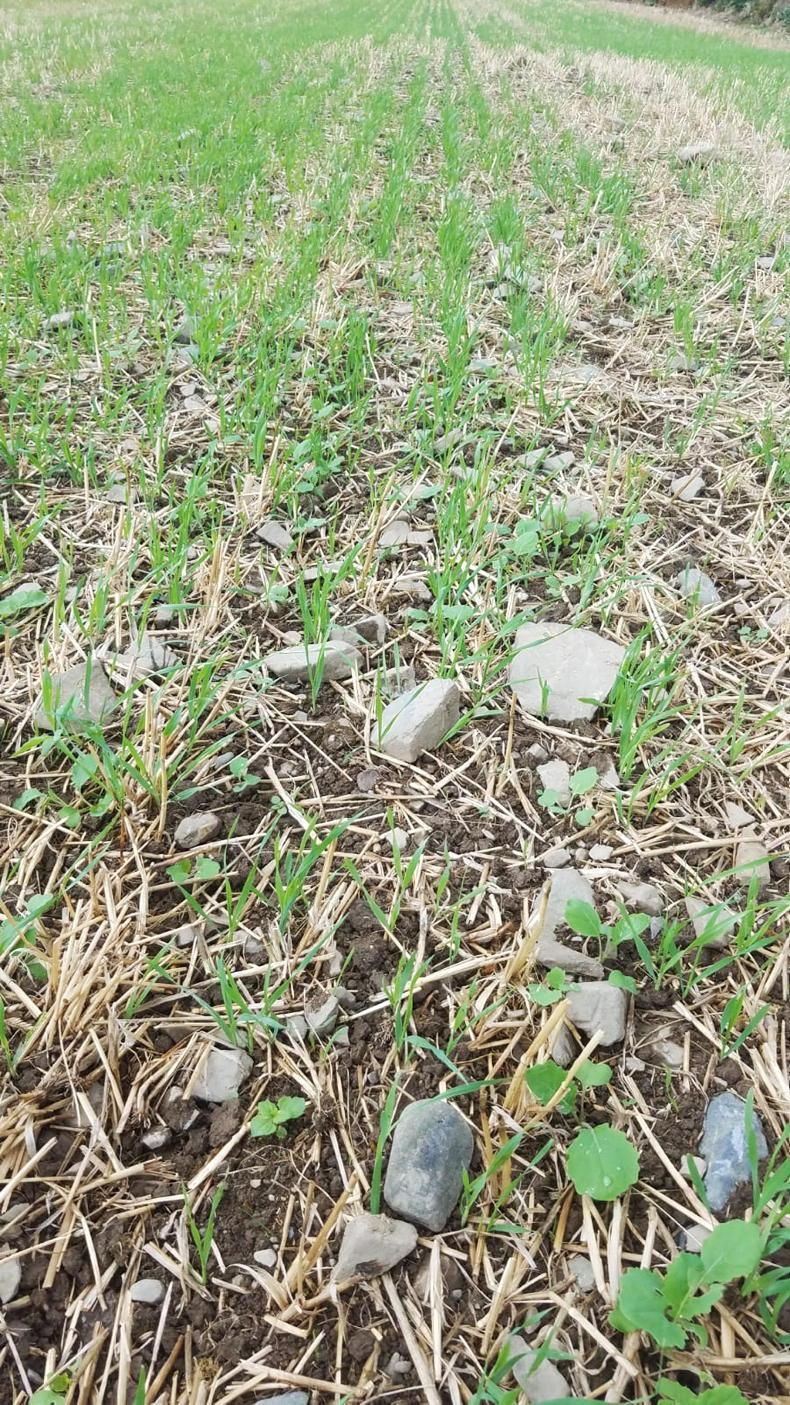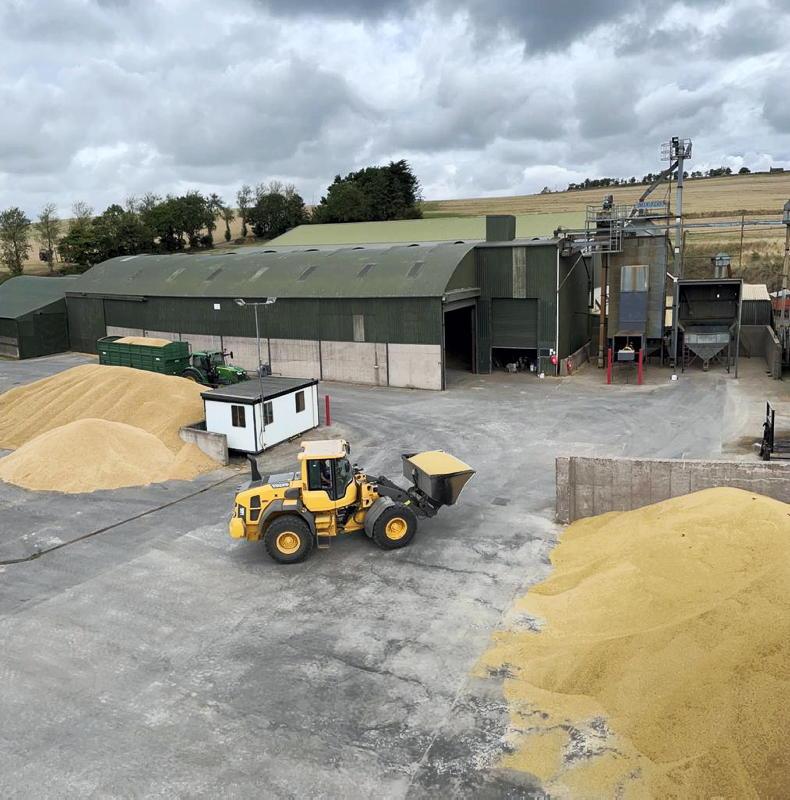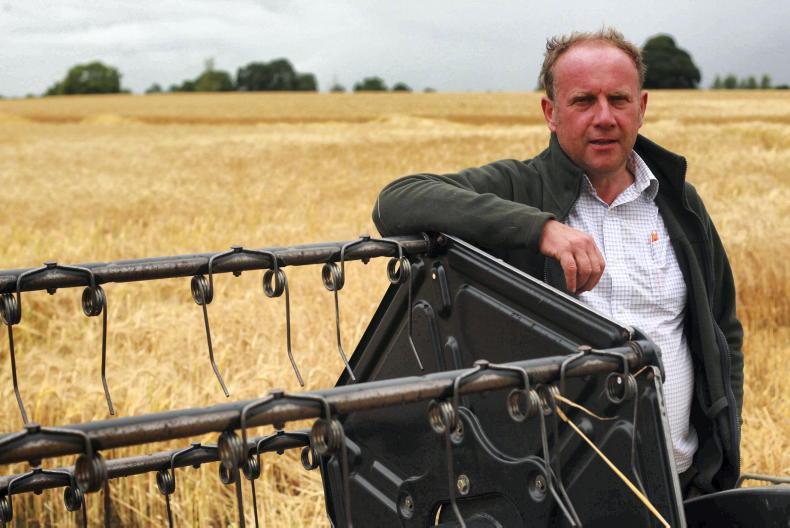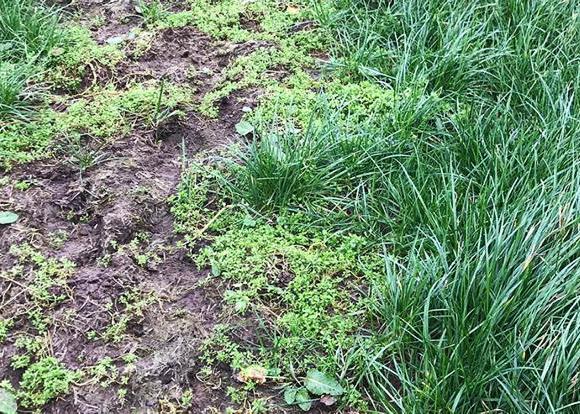Derek Rodgers was cultivating oilseed rape stubble when we chatted on Monday. He was hoping to allow seeds to germinate and lower slug pressure. The rape was also very tall and there is tall stubble so it will be disced after the grubber has travelled through it.
The disc is busy cultivating stubbles for grass weed control. Brome is a concern on the farm and cultivating headlands is a priority.
Derek is happy to be able to get these jobs done after an early harvest. Winter wheat harvesting finished up at the end of last week. A lot of wheat was cut at 11.5-12% moisture. This eliminated the need for drying completely on some crops which were really ripe at harvest as there were no green grains present at all. Air is being blown into the grain and temperatures are checked regularly. The last of the wheat came in at 16-17% moisture content and it was dried.
Yields were very good, ranging from 4t/ac to over 5t/ac with bushels of 75-78. The crops after oilseed rape and potatoes were at the higher end of the yield scale.
Oilseed rape averaged 2.3t/ac at 8.5-10% moisture content. It was slow to come in and the stalks were quite green at cutting. It was difficult to cut, but Derek was happy with the yield.
Derek said “it was a harvest we couldn’t complain about”.
Rape and oat straw were chopped, while winter wheat was sold for mushroom compost and was yielding about 3.5-4.5 8X4X4 bales per acre.
In the potato fields, the Queens harvest continues while the first of the Roosters have been desiccated. Dry matter contents have been high so far and the dry weather has brought a risk of bruising to crops.
Onions were harvested in perfect conditions. They like the dry weather and Derek was happy with the crop.
Oilseed rape might be planted next week. Derek is waiting for some more moisture before planting. Drainage work was carried out in the good weather and hedge-cutting and ploughing are jobs on the list for September.
Iain McMordie is waiting on some dry weather to cut his spring oats. They are ready for harvesting. After this, his spring beans crop is the only one left to be cut. Some of the pods have turned black, but the stems are still green. Iain expects to harvest the crop in the second or third week of September.
The past month has been busy as winter barley, oilseed rape and winter wheat were all harvested. Winter barley was somewhat disappointing at 3t/ac, but this was a similar story across the entire country. Winter wheat yields ranged from 3.7t/ac to 4.4t/ac at moisture contents of 13-20%. The last of the crop came in at higher moistures as rain fell.

A catch crop will be grazed by sheep on Iain's farm.
Only about one-third of the wheat needed to be dried. Iain put anything over 14% through the dryer and while he had no bushel results, Iain said the trailers were weighing very well.
Wheat straw
Half of the wheat straw was chopped and Iain had plenty of customers for the winter barley straw. Oilseed rape straw was chopped and the oaten straw is due to be chopped.
Iain has drilled oats for sheep to graze over winter. The crop will help to soak up nutrients and the sheep will help to recycle those nutrients. Spring beans will be planted after these crops.
Winter oilseed rape will be planted as soon as it is dry enough to do so. When we chatted on Monday the land was a little bit sticky.
Iain recently purchased a Dale drill and he will be giving it a good test in the weeks ahead. It is a 6m drill, a big change from the 3m which he was working with, so it should speed up work considerably.
Overall Iain was very happy with the harvest. The weather was very good and there were no breakdowns. It made the work a lot easier.
The Twomeys are busy this week. There’s spring wheat to be cut when weather allows, grain to be dried, straw to be baled and much more.
Rain stopped work at the weekend but the combine was going again on Monday evening. It was too early for yield levels, but the crop of Duncan was bushelling at 77 to 78.
There is still some late-sown spring barley to be cut, but the spring barley harvest started on the farm on 3 August. Moisture contents range from 14% to 17%, while the average yield was 3.5t/ac with a range from 3.25t/ac to 3.75t/ac. The crop bushelled between 68 and 72. Any crops destined for malting made the grade with most protein levels at 10% or over.

Grain being processed on Twomey's farm in Co Cork.
Dan was disappointed with his spring oats crop which yielded 3.25t/ac and had a KPH value of 56. However, it was cut at 13% moisture content.
Baling is up to date. Some spring barley straw was chopped on the farm, but in general the crop was yielding 5 8X4X3 bales per acre.
At present the yard is very busy. Grain is dried, cleaned and stored on the farm for feed buyers, as well as the farm’s own grain. There was a lot less drying this year due to the low moisture levels, but grain came in very quickly so there was pressure on to get it cleared. Moisture levels of grain being cut now are back to 19-20%.
Cultivation, rogueing wild beet and applying a fungicide to beet crops are all jobs on the current agenda, while Dan is also choosing fields and varieties for winter crops. In the coming weeks glyphosate will be applied to control grass weeds on stubble ground, while lime will also be applied.
Ploughing will start from about 20 September weather permitting.
Dan is happy with how the harvest went. However, he was disappointed with his winter barley yields. He noted that it is becoming trickier to grow winter barley, but he will not be reducing his acreage based on this year’s results.
Derek Rodgers was cultivating oilseed rape stubble when we chatted on Monday. He was hoping to allow seeds to germinate and lower slug pressure. The rape was also very tall and there is tall stubble so it will be disced after the grubber has travelled through it.
The disc is busy cultivating stubbles for grass weed control. Brome is a concern on the farm and cultivating headlands is a priority.
Derek is happy to be able to get these jobs done after an early harvest. Winter wheat harvesting finished up at the end of last week. A lot of wheat was cut at 11.5-12% moisture. This eliminated the need for drying completely on some crops which were really ripe at harvest as there were no green grains present at all. Air is being blown into the grain and temperatures are checked regularly. The last of the wheat came in at 16-17% moisture content and it was dried.
Yields were very good, ranging from 4t/ac to over 5t/ac with bushels of 75-78. The crops after oilseed rape and potatoes were at the higher end of the yield scale.
Oilseed rape averaged 2.3t/ac at 8.5-10% moisture content. It was slow to come in and the stalks were quite green at cutting. It was difficult to cut, but Derek was happy with the yield.
Derek said “it was a harvest we couldn’t complain about”.
Rape and oat straw were chopped, while winter wheat was sold for mushroom compost and was yielding about 3.5-4.5 8X4X4 bales per acre.
In the potato fields, the Queens harvest continues while the first of the Roosters have been desiccated. Dry matter contents have been high so far and the dry weather has brought a risk of bruising to crops.
Onions were harvested in perfect conditions. They like the dry weather and Derek was happy with the crop.
Oilseed rape might be planted next week. Derek is waiting for some more moisture before planting. Drainage work was carried out in the good weather and hedge-cutting and ploughing are jobs on the list for September.
Iain McMordie is waiting on some dry weather to cut his spring oats. They are ready for harvesting. After this, his spring beans crop is the only one left to be cut. Some of the pods have turned black, but the stems are still green. Iain expects to harvest the crop in the second or third week of September.
The past month has been busy as winter barley, oilseed rape and winter wheat were all harvested. Winter barley was somewhat disappointing at 3t/ac, but this was a similar story across the entire country. Winter wheat yields ranged from 3.7t/ac to 4.4t/ac at moisture contents of 13-20%. The last of the crop came in at higher moistures as rain fell.

A catch crop will be grazed by sheep on Iain's farm.
Only about one-third of the wheat needed to be dried. Iain put anything over 14% through the dryer and while he had no bushel results, Iain said the trailers were weighing very well.
Wheat straw
Half of the wheat straw was chopped and Iain had plenty of customers for the winter barley straw. Oilseed rape straw was chopped and the oaten straw is due to be chopped.
Iain has drilled oats for sheep to graze over winter. The crop will help to soak up nutrients and the sheep will help to recycle those nutrients. Spring beans will be planted after these crops.
Winter oilseed rape will be planted as soon as it is dry enough to do so. When we chatted on Monday the land was a little bit sticky.
Iain recently purchased a Dale drill and he will be giving it a good test in the weeks ahead. It is a 6m drill, a big change from the 3m which he was working with, so it should speed up work considerably.
Overall Iain was very happy with the harvest. The weather was very good and there were no breakdowns. It made the work a lot easier.
The Twomeys are busy this week. There’s spring wheat to be cut when weather allows, grain to be dried, straw to be baled and much more.
Rain stopped work at the weekend but the combine was going again on Monday evening. It was too early for yield levels, but the crop of Duncan was bushelling at 77 to 78.
There is still some late-sown spring barley to be cut, but the spring barley harvest started on the farm on 3 August. Moisture contents range from 14% to 17%, while the average yield was 3.5t/ac with a range from 3.25t/ac to 3.75t/ac. The crop bushelled between 68 and 72. Any crops destined for malting made the grade with most protein levels at 10% or over.

Grain being processed on Twomey's farm in Co Cork.
Dan was disappointed with his spring oats crop which yielded 3.25t/ac and had a KPH value of 56. However, it was cut at 13% moisture content.
Baling is up to date. Some spring barley straw was chopped on the farm, but in general the crop was yielding 5 8X4X3 bales per acre.
At present the yard is very busy. Grain is dried, cleaned and stored on the farm for feed buyers, as well as the farm’s own grain. There was a lot less drying this year due to the low moisture levels, but grain came in very quickly so there was pressure on to get it cleared. Moisture levels of grain being cut now are back to 19-20%.
Cultivation, rogueing wild beet and applying a fungicide to beet crops are all jobs on the current agenda, while Dan is also choosing fields and varieties for winter crops. In the coming weeks glyphosate will be applied to control grass weeds on stubble ground, while lime will also be applied.
Ploughing will start from about 20 September weather permitting.
Dan is happy with how the harvest went. However, he was disappointed with his winter barley yields. He noted that it is becoming trickier to grow winter barley, but he will not be reducing his acreage based on this year’s results.













SHARING OPTIONS